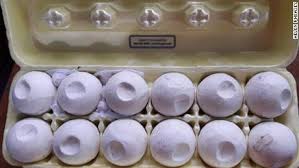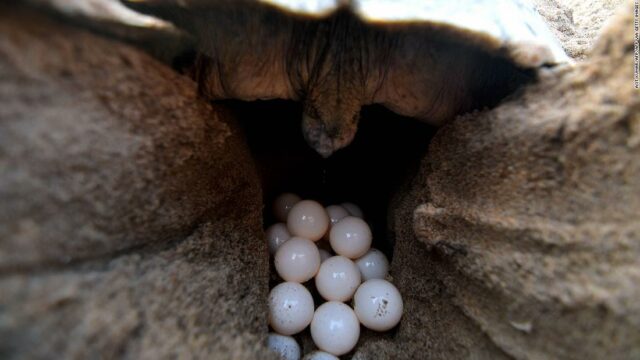
The phone rang as a tracker activated and a small circular blink appeared on the map. Helen Pheasey closely watched the point as it moved inland from a beach on the Pacific coast of Costa Rica.
“It just kept moving,” she says. “Every hour I’m checking it, and it goes further and further Pheasey, then a PhD student at the Durrell Institute for Conservation and Ecology in the UK, was tracking down a stolen item, but not the usual kind.
The point was tracking the journey of a mock turtle egg, which Pheasey had planted deep in a real turtle nest the day before. The egg was poached and trafficked to a supermarket loading dock 85 miles away, where it was likely sold.
The mock turtle egg, dubbed the InvestEGGator, about the size of a ping pong ball, was developed by scientists at the United States-based conservation organization Paso Pacífico, which focuses on protecting coastal ecosystems in Central America.
The fake eggs are made from a rubbery material called NinjaFlex. They are smeared with a special textured paint, developed by Hollywood special effects artist Lauren Wilde, that casts a yellowish tint.
The development of false turtle eggs

The fake eggs look and feel like the real thing, but hidden inside them is a SIM card with a GPS transmitter, which uses mobile networks to transfer location data and a USB port for charging. Paso Pacifico developed the lures as a tool to combat egg trafficking.
The organization estimates that poachers destroy more than 90% of sea turtle nests on many of Central America’s unprotected beaches to sell the eggs in the illegal wildlife trade. In a two-year research project that began in 2017, Pheasey deployed 101 false eggs in olive ridley and green sea turtle nests on four beaches in Costa Rica, to test its effectiveness in tracking trade routes. The results of their study, released this year, show that the devices could help break the illegal wildlife trade not just in turtles, but in a number of vulnerable species.
This is how they planted the fake eggs
Pheasey and her team planted the decoy eggs overnight, once the turtles had dug their nests and sneaked back to the sea. With only one fake egg hidden within a clutch of more than 100 eggs, she hoped they would go undetected by poachers. If the fake eggs were removed from the nests, the SIM card would find a signal and send an alert with GPS coordinates to Pheasey. “It’s like a cell phone,” she says. “If you bury your phone in the sand, you won’t have any signal, but as soon as they surface, they will connect”.
Of the 101 decoy eggs deployed, a quarter were collected illegally and five leads were successfully provided. The tracks varied in length. One lure traveled less than 50 meters to the nearest beach house, another moved two kilometers to the nearest bar, while another went 137 kilometers inland, providing solid evidence of the turtle egg trade. In some cases, the decoy trips revealed the entire business chain – from the poacher to the vendor to a customer’s residence, Pheasey says.
Surveillance of the illegal turtle trade
This intelligence could help strengthen law enforcement by allowing authorities to target smugglers and criminal networks rather than local poachers, who are generally “marginalized individuals trying to make a quick buck,” Pheasey says.
While coastal communities have consumed turtle eggs for centuries, increasing demand in towns and cities around the world, combined with other growing threats to turtles, such as overfishing and entanglement with nets, makes this practice unsustainable, says Sarah Otterstrom, conservation scientist and executive director of Paso Pacifico.
“They are now considered a delicacy and an aphrodisiac,” Otterstrom told. “In many bars and restaurants, people make turtle egg soup or put a raw turtle egg in a drink.” As turtle populations decline, protecting their eggs is crucial to ensuring their survival.
However, before decoy eggs can be used effectively for conservation and law enforcement, some hurdles remain. Paso Pacifico is working to extend the battery life of the eggs, which only lasts a few days when the eggs send location alerts every hour.
Pheasey identified low signal reception in coastal areas as another possible limitation, but Otterstrom doesn’t see this as a major problem. “Although there may be beaches that are remote and do not have cell phone technology, as the eggs make their way to the markets, they will inevitably encounter cell phone towers, what’s important is that the tracking technology is affordable, widely available, and works in most countries around the world, so it can be used to identify cross-border trade”, he says.
Intelligence to prevent the illegal trade in turtle eggs
Paso Pacífico sells its turtle egg lures for about $ 60 per egg, to conservation projects and law enforcement agencies, including an undisclosed South American government. Otterstrom says Paso Pacifico is planning to adapt the technology to work with other species whose eggs are vulnerable to illegal trade, such as parrots or crocodiles.
The organization is working with a group in Ecuador to combat the appalling practice of shark finning by developing tracking devices that could be embedded in the fins of sharks caught as bycatch and sold legally. This would help reveal international trade routes, Otterstrom says.
With the global illegal wildlife trade estimated to be worth up to $ 23 billion annually, decoy tracking technology is a tool with great potential. Intelligence is key to prevention, it means that you are always ahead of poachers and not behind.

